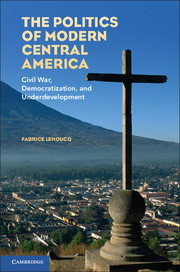Book contents
- Frontmatter
- Contents
- Figures
- Tables
- Introduction
- 1 Central America on the Eve of the 1980s
- 2 Civil War, Revolution, and Economic Collapse
- 3 Stalemates, Peace Negotiations, and Democratization
- 4 Economic Stability, Lackluster Growth, and Social Change
- 5 Democratization, State Capacity, and Redistribution
- Conclusion
- Bibliography
- Index
2 - Civil War, Revolution, and Economic Collapse
Published online by Cambridge University Press: 05 September 2012
- Frontmatter
- Contents
- Figures
- Tables
- Introduction
- 1 Central America on the Eve of the 1980s
- 2 Civil War, Revolution, and Economic Collapse
- 3 Stalemates, Peace Negotiations, and Democratization
- 4 Economic Stability, Lackluster Growth, and Social Change
- 5 Democratization, State Capacity, and Redistribution
- Conclusion
- Bibliography
- Index
Summary
Introduction
Civil war raged in Central America throughout the 1980s and into the 1990s. It led to the killing of at least 300,000 people, the vast majority of whom were civilians. It produced between 1.8 million and 2.8 million refugees. War also devastated the economies of El Salvador, Guatemala, and Nicaragua. It was not until the first decade of the twenty-first century, as we will see in Chapter 4, that GDP per capita rates regained prewar levels.
These were surprising outcomes because civil wars rarely happen. There was less than a 2 percent probability that a country, in any given year, experienced an ongoing attempt to overthrow the government (and in which at least 1,000 soldiers and insurgents lost their lives) between 1945 and 2000 (Fearon and Laitin, 2003; Sambanis, 2004). Revolutions – or rebellions that toppled governments and tried to transform their societies – are rarer still. Since the French Revolution of 1789, there have been only seventeen social revolutions, a number that increases by half if we include the “velvet” revolutions of Eastern Europe after the fall of the Berlin Wall (Goodwin, 2001: 4).
The same methods suggest that civil war was a lot more common in Central America. Sixteen percent of the country-years in Central America involved violent conflict between governments and insurgents – eight times more than in the rest of the world. What made civil war so much more likely on the isthmus? One popular response to this question, especially common during the 1970s and 1980s, is that poverty and underdevelopment made conflict “inevitable,” to cite the title of one diplomatic historian’s account of these years (LaFeber, 1983). It is very much this account that quantitative, cross- national studies champion. Another reply emphasizes political dynamics, one that suggests that the closed nature of most political systems left the deployment of violence a viable (unfortunately) option to end tyranny in Central America.
- Type
- Chapter
- Information
- The Politics of Modern Central AmericaCivil War, Democratization, and Underdevelopment, pp. 30 - 65Publisher: Cambridge University PressPrint publication year: 2012

